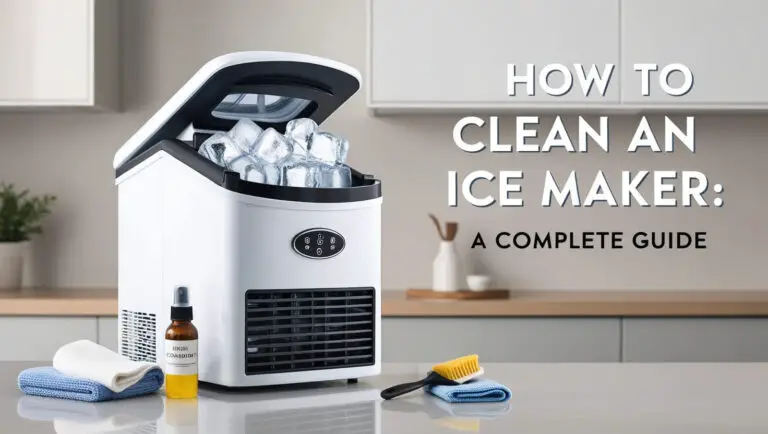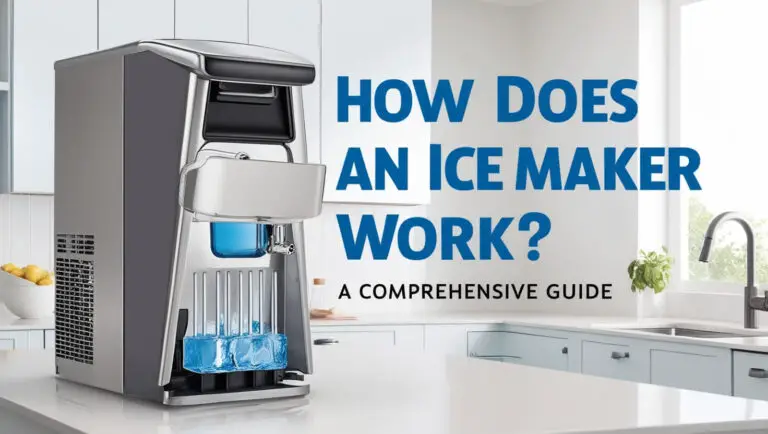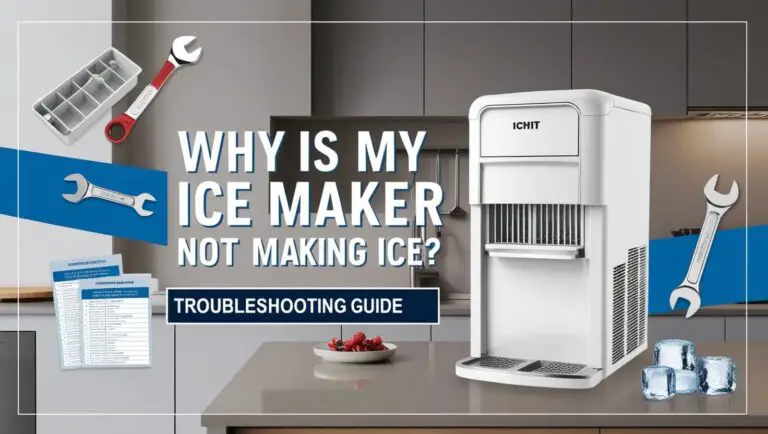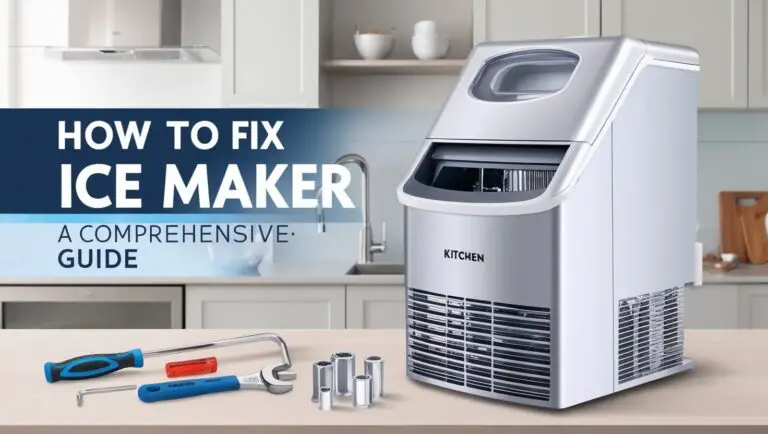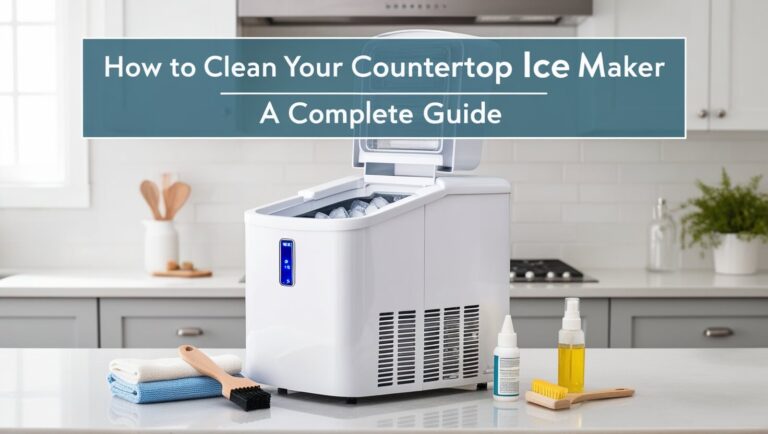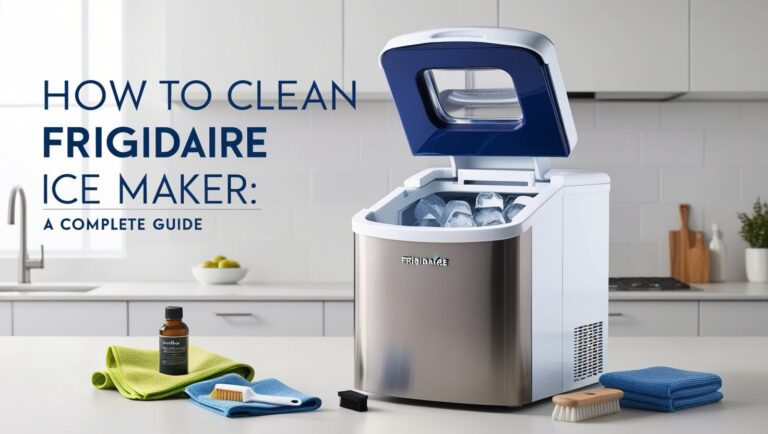How to Clean a Portable Ice Maker?
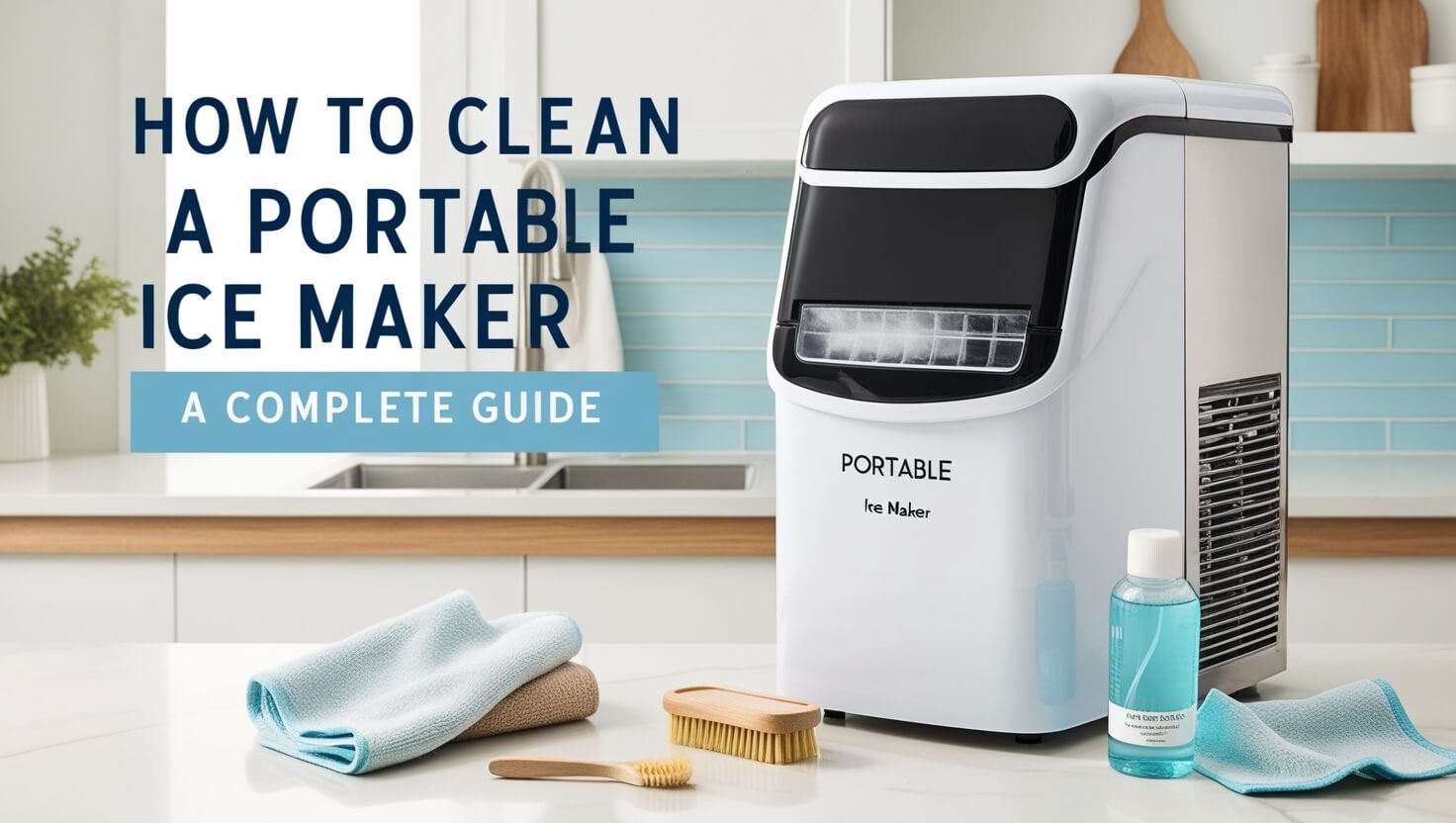
Are you wondering how to clean a portable ice maker? You’re in the right place! Keeping your portable ice maker clean is crucial for producing fresh, high-quality ice and maintaining the appliance’s longevity. In this comprehensive guide, we’ll walk you through everything you need to know about cleaning your portable ice maker, from daily maintenance to deep cleaning techniques.
Portable ice makers are convenient appliances that allow you to enjoy fresh ice anytime, anywhere. However, without proper cleaning, they can become breeding grounds for bacteria, mold, and mineral buildup. Regular cleaning ensures that your ice maker continues to produce clean, safe ice while operating efficiently.
Let’s dive into the world of portable ice maker maintenance and discover how to keep your ice crystal clear and your machine in top shape.
Why Regular Cleaning of Your Portable Ice Maker is Important
Cleaning your portable ice maker isn’t just about keeping it looking nice. It’s a crucial part of maintaining the appliance and ensuring the quality of the ice you consume. Here’s why regular cleaning should be a priority:
Health and Safety Considerations
Your portable ice maker deals with water and ice, which can create a perfect environment for bacteria and mold growth if not properly maintained. Regular cleaning helps prevent the buildup of harmful microorganisms that could contaminate your ice and potentially make you sick.
Mold and bacteria thrive in moist environments, and the damp interior of an ice maker provides ideal conditions for their growth. By cleaning your ice maker regularly, you eliminate these potential health hazards and ensure that the ice you’re using in your drinks is safe and hygienic.
Improved Ice Quality and Taste
Have you ever noticed that ice from a dirty ice maker can have an off-taste or smell? That’s because contaminants in the machine can affect the quality of the ice it produces. Regular cleaning helps maintain the purity of your ice, ensuring that it doesn’t pick up any unwanted flavors or odors.
Clean ice not only tastes better but also looks better. Ice from a well-maintained machine is typically clearer and more aesthetically pleasing, which can enhance the overall experience of your cold beverages.
Extended Lifespan of Your Ice Maker
Like any appliance, a portable ice maker will last longer if it’s well-maintained. Regular cleaning prevents the buildup of mineral deposits and scale, which can damage the internal components of your ice maker over time.
By keeping your ice maker clean, you’re protecting its mechanisms from wear and tear, potentially saving you money on repairs or replacements in the long run. A clean ice maker also operates more efficiently, which can help reduce energy consumption and further extend the life of the appliance.
Understanding Your Portable Ice Maker
Before we dive into the cleaning process, it’s important to understand the basics of your portable ice maker. This knowledge will help you clean more effectively and safely.
Types of Portable Ice Makers
Portable ice makers come in various types, each with its own unique features:
- Countertop Ice Makers: These are the most common type of portable ice makers. They’re compact, easy to move, and don’t require a water line connection.
- Undercounter Ice Makers: While not as portable as countertop models, these units are still considered portable as they can be moved and aren’t permanently installed.
- Nugget Ice Makers: These produce small, chewable ice pieces and are becoming increasingly popular for home use.
Understanding which type you have can help you tailor your cleaning approach to suit your specific model.
Common Components and Their Functions
Regardless of the type, most portable ice makers share some common components:
- Water Reservoir: This is where you add water for ice production.
- Ice Basket or Bin: Where the finished ice is stored.
- Ice Scoop: Used for retrieving ice from the bin.
- Control Panel: Where you operate the ice maker.
- Evaporator Fingers or Rods: These freeze the water to form ice.
- Water Pump: Circulates water during the ice-making process.
- Condenser: Helps cool the water for ice production.
Knowing these components will help you clean your ice maker more thoroughly and avoid damaging any crucial parts during the cleaning process.
Essential Supplies for Cleaning Your Portable Ice Maker
Before you start cleaning your portable ice maker, it’s important to gather all the necessary supplies. Having everything on hand will make the cleaning process smoother and more efficient.
Cleaning Solutions: DIY vs. Commercial Options
When it comes to cleaning solutions, you have two main options: DIY mixtures or commercial cleaners specifically designed for ice makers.
DIY Cleaning Solutions:
- Vinegar Solution: Mix equal parts water and white vinegar. This solution is effective for general cleaning and mild descaling.
- Lemon Juice Solution: Mix one part lemon juice with three parts water. This is a natural, fresh-smelling alternative to vinegar.
- Baking Soda Paste: Mix baking soda with a small amount of water to create a paste. This is great for scrubbing stubborn stains.
Commercial Cleaning Solutions:
- Ice Machine Cleaners: These are specifically formulated to clean and sanitize ice makers without damaging the components.
- Descaling Solutions: These are designed to remove mineral buildup and scale from your ice maker.
While DIY solutions are cost-effective and usually sufficient for regular cleaning, commercial cleaners might be necessary for deep cleaning or addressing specific issues like heavy scale buildup.
Tools and Materials You’ll Need
In addition to your chosen cleaning solution, you’ll need the following tools and materials:
- Soft Cloths or Microfiber Towels: For wiping down surfaces without scratching.
- Soft-Bristled Brush or Toothbrush: For scrubbing hard-to-reach areas.
- Sponge: For general cleaning of larger surfaces.
- Rubber Gloves: To protect your hands during cleaning.
- Spray Bottle: For applying cleaning solutions evenly.
- Clean, Lint-Free Towels: For drying components after cleaning.
- Ice Scoop: For removing ice before cleaning.
- Large Bowl or Bucket: For disposing of old ice and holding cleaning solutions.
- Distilled Water: For rinsing and making ice after cleaning (optional, but recommended for better ice quality).
Having these supplies ready will help ensure that you can clean your portable ice maker thoroughly and efficiently.
Step-by-Step Guide to Cleaning Your Portable Ice Maker
Now that you have all your supplies ready, let’s walk through the process of cleaning your portable ice maker. Following these steps will help ensure a thorough clean and keep your ice maker in top condition.
Preparing Your Ice Maker for Cleaning
- Unplug the ice maker: Safety first! Always disconnect the power before cleaning any electrical appliance.
- Remove all ice: Dispose of any ice in the bin or basket. Don’t reuse this ice after cleaning.
- Allow the unit to defrost: If there’s any frost buildup, let it melt completely before proceeding.
- Remove removable parts: Take out the ice basket, scoop, and any other removable components.
Cleaning the Exterior
- Prepare your cleaning solution: Mix your chosen cleaner with water as directed.
- Wipe down the exterior: Use a soft cloth dampened with the cleaning solution to clean the outside of the ice maker. Pay extra attention to the control panel and any crevices where dirt might accumulate.
- Dry the exterior: Use a clean, dry cloth to wipe away any moisture, preventing water spots or streaks.
Cleaning the Ice Bin and Scoop
- Wash with warm, soapy water: Clean the ice bin and scoop thoroughly with mild dish soap and warm water.
- Sanitize: Rinse with a sanitizing solution (1 tablespoon of bleach per gallon of water) or a commercial sanitizer.
- Rinse and dry: Rinse well with clean water and dry completely with a lint-free towel.
Cleaning the Interior Components
- Clean the water reservoir: Wipe down the inside of the water reservoir with your cleaning solution. If it’s removable, you can wash it separately.
- Clean the evaporator rods or fingers: Gently clean these with a soft brush dipped in your cleaning solution. Be careful not to bend or damage them.
- Wipe down other interior surfaces: Clean all other accessible interior parts with your cleaning solution.
- Address mineral buildup: If you notice scale or mineral deposits, use a descaling solution or a vinegar solution to remove them.
Sanitizing Your Portable Ice Maker
- Prepare a sanitizing solution: Mix 1 tablespoon of bleach per gallon of water, or use a commercial ice maker sanitizer.
- Apply the solution: Using a spray bottle or cloth, apply the sanitizing solution to all interior surfaces.
- Let it sit: Allow the sanitizing solution to sit for about 5 minutes.
- Rinse thoroughly: Use clean water to rinse all surfaces multiple times, ensuring no sanitizer residue remains.
Reassembling and Testing Your Ice Maker
- Dry all components: Use a clean, lint-free towel to dry all parts thoroughly.
- Reassemble the ice maker: Put all removable parts back in place.
- Run a cleaning cycle: If your ice maker has a cleaning cycle, run it now. If not, proceed to the next step.
- Make and discard two batches of ice: This helps flush out any remaining cleaning solution and ensures your ice maker is producing clean ice.
- Clean the exterior once more: Give the exterior a final wipe-down to remove any water spots or fingerprints.
By following these steps, you’ll ensure that your portable ice maker is clean, sanitized, and ready to produce fresh, clean ice.
Dealing with Mineral Deposits and Scale Buildup
One of the most common issues with portable ice makers is the accumulation of mineral deposits and scale. This is especially true if you live in an area with hard water. Let’s look at how to identify and address this problem.
Identifying Scale Buildup
Scale buildup can be identified by:
- White or cloudy residue on interior surfaces
- Chalky deposits on evaporator rods or fingers
- Decreased ice production or quality
- Strange tastes or odors in the ice
If you notice any of these signs, it’s time to descale your portable ice maker.
Descaling Methods for Portable Ice Makers
- Vinegar Method:
- Mix equal parts water and white vinegar.
- Fill the water reservoir with this solution.
- Run the ice maker through 2-3 cycles, discarding the ice each time.
- Rinse thoroughly with clean water.
- Run 2-3 cycles with clean water, discarding the ice.
- Commercial Descaler:
- Follow the manufacturer’s instructions for dilution and application.
- These products are often more effective for heavy scale buildup.
- Lemon Juice Method:
- Mix 2-3 tablespoons of lemon juice per quart of water.
- Use this solution in the same way as the vinegar method.
Remember, prevention is better than cure. Using filtered or distilled water in your ice maker can significantly reduce scale buildup over time.
Maintaining Your Portable Ice Maker Between Deep Cleans
While deep cleaning is essential, regular maintenance can keep your portable ice maker in top condition and reduce the frequency of deep cleans needed.
Daily and Weekly Maintenance Tips
Daily:
- Wipe down the exterior with a damp cloth.
- Empty and dry the ice bin if not in use.
- Leave the lid open when not in use to prevent mold growth.
Weekly:
- Clean the ice scoop with warm, soapy water.
- Wipe down the interior of the ice bin with a mild cleaning solution.
- Check for any signs of mineral buildup or mold.
When to Replace Filters (if applicable)
Some portable ice makers come with built-in water filters. If your model has one:
- Check the manufacturer’s recommendations for filter replacement frequency.
- Generally, replace filters every 3-6 months or after producing 3,000-6,000 pounds of ice.
- Replace filters immediately if you notice a change in ice taste or quality.
Regular maintenance not only keeps your ice maker clean but also helps you spot potential issues early, preventing more serious problems down the line.
Troubleshooting Common Cleaning Issues
Even with regular cleaning, you might encounter some issues. Here’s how to address common problems:
Addressing Persistent Odors
If your ice maker or ice has a persistent odor:
- Clean with a baking soda solution (1/4 cup baking soda per quart of warm water).
- Place an open box of baking soda near the ice maker when not in use.
- Use a commercial odor eliminator designed for ice makers.
Dealing with Stubborn Stains
For tough stains:
- Make a paste with baking soda and water.
- Apply to the stain and let sit for 10-15 minutes.
- Scrub gently with a soft brush and rinse thoroughly.
What to Do If Your Ice Maker Won’t Start After Cleaning
If your ice maker doesn’t start after cleaning:
- Ensure it’s properly plugged in and turned on.
- Check that all components are correctly reassembled.
- Make sure the water reservoir is filled to the correct level.
- Allow the unit to sit unplugged for an hour, then try again.
If problems persist, consult your user manual or contact the manufacturer’s customer service.
Frequency of Cleaning: How Often Should You Clean Your Portable Ice Maker?
The frequency of cleaning your portable ice maker depends on several factors. Let’s break it down:
Factors Affecting Cleaning Frequency
- Usage: The more you use your ice maker, the more often it needs cleaning.
- Water quality: Hard water leads to faster mineral buildup, requiring more frequent cleaning.
- Environment: Dusty or humid environments may necessitate more frequent cleaning.
- Storage: Ice makers used intermittently and stored between uses may need cleaning before each use.
Creating a Cleaning Schedule
Based on these factors, here’s a general cleaning schedule:
- Light use (1-2 times a week):
- Deep clean every 3-4 months
- Sanitize monthly
- Moderate use (3-4 times a week):
- Deep clean every 2-3 months
- Sanitize bi-weekly
- Heavy use (daily):
- Deep clean monthly
- Sanitize weekly
- Commercial or high-capacity use:
- Deep clean bi-weekly
- Sanitize daily or every other day
Remember, these are general guidelines. Adjust based on your specific usage and the quality of ice produced. If you notice any changes in ice quality, taste, or smell, it’s time for a clean regardless of the schedule.
Environmental Considerations When Cleaning Your Portable Ice Maker
As we become more environmentally conscious, it’s important to consider the ecological impact of our cleaning practices. Here are some ways to clean your portable ice maker more sustainably:
Eco-Friendly Cleaning Solutions
- Vinegar: A natural, biodegradable cleaner that’s effective for most cleaning tasks.
- Lemon Juice: Another natural option that leaves a fresh scent.
- Baking Soda: Great for scrubbing and deodorizing without harsh chemicals.
- Eco-Certified Commercial Cleaners: Look for products with environmental certifications.
Using these alternatives reduces the amount of harmful chemicals released into the environment.
Water Conservation Tips
- Reuse rinse water: When possible, use the final rinse water from cleaning to water plants or for other non-potable uses.
- Use a spray bottle: This helps control the amount of water used during cleaning.
- Collect and repurpose ice: During the cleaning process, collect the ice produced and use it for watering plants or cooling compost.
- Fix leaks promptly: If you notice any leaks in your ice maker, address them immediately to prevent water waste.
By adopting these practices, you can maintain a clean ice maker while minimizing your environmental impact.
Comparing Cleaning Methods for Different Portable Ice Maker Brands
While the general cleaning process is similar for most portable ice makers, some brands may have specific recommendations or features that affect cleaning. Let’s look at some popular brands:
Brand-Specific Cleaning Recommendations
- Igloo Portable Ice Makers:
- Often recommend using a mixture of lemon juice and water for cleaning.
- Some models have a self-cleaning function.
- hOmeLabs Portable Ice Makers:
- Emphasize the importance of regular drain plug cleaning.
- Recommend using their branded cleaning solution for best results.
- Frigidaire Portable Ice Makers:
- Suggest using a mild detergent solution for general cleaning.
- Recommend against using abrasive cleaners or solvents.
- NewAir Portable Ice Makers:
- Advise using a vinegar solution for descaling.
- Some models have removable parts that are dishwasher safe
Universal Cleaning Tips for All Brands Regardless of the brand, there are some universal cleaning tips that apply to most portable ice makers:
- Regular cleaning: Clean your ice maker at least once a month, or more frequently if used heavily.
- Use food-safe cleaners: Always use cleaners that are safe for food-contact surfaces.
- Rinse thoroughly: After cleaning, rinse all parts multiple times to remove any cleaning solution residue.
- Dry completely: Allow all components to air dry completely before reassembling and using the ice maker.
- Check the water filter: If your ice maker has a water filter, replace it according to the manufacturer’s recommendations.
Troubleshooting Common Cleaning Issues
- Persistent odors:
- Soak removable parts in a mixture of baking soda and water.
- Run a cleaning cycle with lemon juice to neutralize odors.
- Mineral buildup:
- Use a descaling solution or a mixture of vinegar and water.
- For stubborn buildup, repeat the process multiple times.
- Mold or mildew:
- Clean thoroughly with a diluted bleach solution (follow manufacturer guidelines).
- Increase cleaning frequency and ensure the ice maker is completely dry between uses.
- Cloudy ice:
- This is often due to mineral content in the water. Use filtered or distilled water.
- Clean the ice maker more frequently to prevent mineral buildup.
Maintenance Tips to Extend Your Ice Maker’s Lifespan
- Use quality water: Filtered or distilled water can reduce mineral buildup and improve ice quality.
- Keep it level: Ensure your ice maker is on a level surface for optimal performance.
- Avoid overfilling: Don’t exceed the maximum water level to prevent overflow and potential damage.
- Regular inspections: Check seals, hoses, and connections for any signs of wear or damage.
- Store properly: If not in use for extended periods, clean thoroughly and store in a dry place.
Environmental Considerations
- Water conservation:
- Reuse the water from melted ice for cleaning or watering plants.
- Consider the frequency of use to avoid wasting water and energy.
- Energy efficiency:
- Choose Energy Star certified models when possible.
- Use the ice maker in a cool area to reduce energy consumption.
- Eco-friendly cleaning:
- Opt for natural cleaning solutions like vinegar and lemon juice when possible.
- Use biodegradable cleaning products to minimize environmental impact.
Let’s Wind UP
Proper cleaning and maintenance of your portable ice maker are essential for ensuring hygienic ice production, optimal performance, and longevity of your appliance. While different brands may have specific recommendations, the core principles of regular cleaning, using appropriate cleaning solutions, and thorough rinsing apply universally.
By following brand-specific guidelines and incorporating universal cleaning tips, you can keep your portable ice maker in top condition. Remember to troubleshoot common issues promptly and implement preventive maintenance measures to extend your ice maker’s lifespan.
Lastly, consider the environmental impact of your ice maker use and cleaning practices. By using water and energy efficiently and opting for eco-friendly cleaning solutions, you can enjoy the convenience of your portable ice maker while minimizing its environmental footprint.
With these comprehensive cleaning and maintenance strategies, you can ensure that your portable ice maker continues to produce clean, fresh ice for all your cooling needs.

